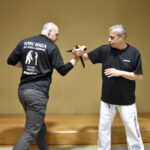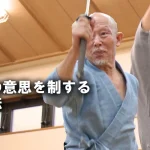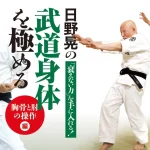Three days of budo in Kyoto: Kyoto Taikai and Shimogamo Jinja koryu enbu
Text and photographs by Grigoris Miliaresis
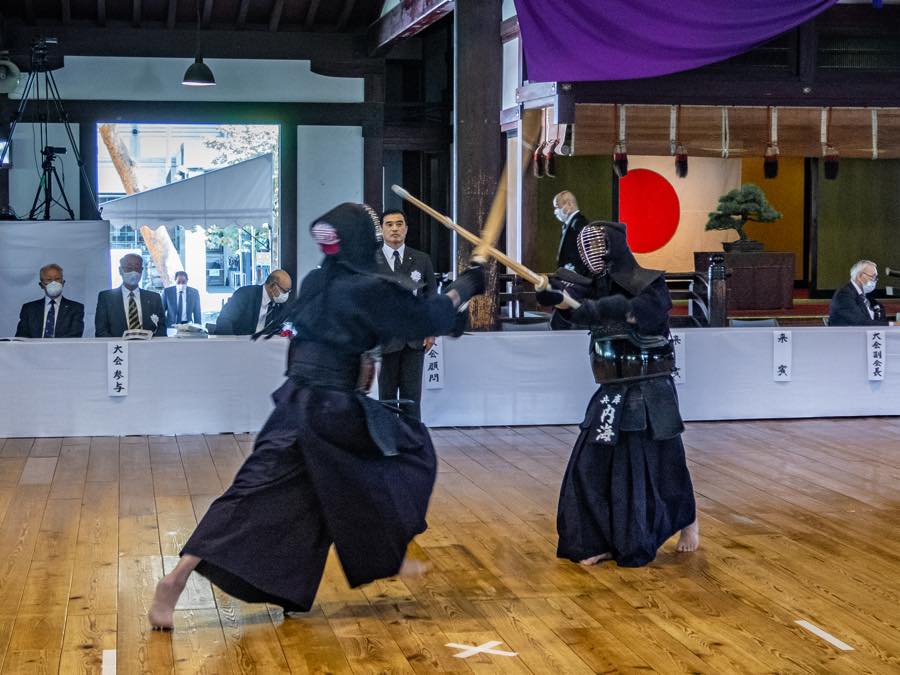
Three days of budo in Kyoto: Kyoto Taikai and Shimogamo Jinja koryu enbu
So let me get something important out of the way first: I don’t share everyone’s fascination with Kyoto. Yes, it is the home of one of my favorite spots in Japan and one my favorite brands of sake (both based in Fushimi, incidentally) but if the discussion goes either-or, I am unequivocally East Coast, from the shores of Kanagawa, to the plateau of Musashino, to the orchards of Hirosaki and if I were to narrow it down, it would be Kanto all the way. It would be foolish to dispute the role that the West played in Japan’s history but the part of this history that is more relevant to me and my personal interests starts with the Kamakura shogunate in the 12th century, passes through Edo, meanders around Kanto and Tohoku and continues to Tokyo.
So why would I decide to spend the better part of this year’s consecutive early May public holidays collectively known as Golden Week in the old capital, struggling with the hordes of tourists from all over the world trying to catch a glimpse of a geisha? Well, there was a reason –actually three: the first was that there are three major budo events going on in Kyoto during GW, the second was that it was the first time someone from Greece would participate in both aspects of arguably the most important of them and the third that this someone is a close friend, a former teacher and a person I care greatly for, Mr. Spiros Drossoulakis.
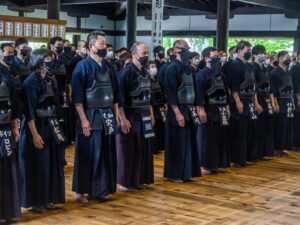
Spiros Drossoulakis (3rd from left)
The events

The old Kyoto Butokuden
For those who aren’t familiar with the events, the first and most important (and the one involving Mr. Drossoulakis) is the Kyoto Taikai taking place at the Butokuden, a beautiful 1899 building originally related to the Dai Nippon Butokukai and built on the grounds of the Heian Jingu; the event was first held in 1895 to celebrate the completion of the shrine that year and except for some special occasions (like during the war or the occupation) it has been held every year and since 1899 at the Butokuden (this year’s was the 119th time). Kyoto Taikai is the biggest event in All-Japan’s Kendo Federation’s (ZNKR) calendar and involves, one day (May 2) of koryu demonstrations followed by jodo and lots and lots of iaido and then three days (May 3, 4 and 5) of kendo, starting from renshi 6th dan and going up to hanshi 8th dan. A 7th dan kyoshi in iaido and 6th dan in kendo, Mr. Drossoulakis was able to participate on both day one (iaido) and day two (kendo) event and this is something no other Greek has done in the past.

Spiros Drossoulakis, day one (iaido)
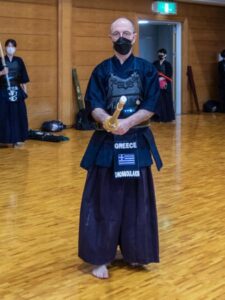
Spiros Drossoulakis, day two (kendo)
The other two events, are not related to ZNKR and kendo: they are two koryu demonstrations, sponsored by the Nihon Kobudo Shinkokai, one held on May 4 at the Shimogamo Jinja shrine and one held on May 5 at the Shiramine Jingu shrine; with 38 schools spread over two demonstration areas in the former and 25 in the latter, these two days provide koryu enthusiasts with a rare opportunity to watch two enbu on two consecutive days. And while the schools for the most part overlap, every demonstration has something new to offer so anyone interested in Japan’s classical traditions should definitely keep these dates in mind. And if they are interested in budo in general, a combination of all three events really is a sampler of its state in present day-Japan.

Opening ceremony before the koryu demonstrations at the Shimogamo Jinja shrine
The Butokuden

Iaido ddemonstrators’ waiting area in the Butokuden
Truth be told there is something unique in the Butokuden events and it is, of course, the venue itself: between Gyokuza, the Emperor’s seat in the center (where no-one seats, of course), the limited seats, the floor that has been polished by thousands of feet over the decades, the light coming from the four doors in the four cardinal directions, the handwritten nameplates and the live announcements of the participant’s names, an enbu there is much different from one at, say, the Nippon Budokan. As a matter of fact, at least to me, the Butokuden creates a stronger sense of awe than the Budokan, despite the fact that the Tokyo venue can pack over 14,000 of spectators; the Butokuden makes things much more personal and at the same time carries the weight of over one and a half century history. And while there’s a lot that could be said about some aspects of this history, especially the early ones, its presence is unmistakably there.

Kendo demonstrators waiting area in the new Kyoto Budo Center: everybody was wearing a mask
For some reason that I can’t fathom, and despite the fact that the government had declared the mitigation of the Covid measures over two weeks before the event, the organizers decided to err in the side of caution: no audience was allowed outside participants (who were encouraged to leave after their demonstration) and those who were inside the Butokuden (secretariat, officials, press etc.) had to wear a face mask. And while wearing a mask is very natural for anyone living in Japan the last 100 years, not allowing for an audience was certainly a disappointment for the participants; I say “certainly” because I heard several people comment on that, all Japanese and several of the highest grades (of which you get a lot in this event!)
Kendo and beyond
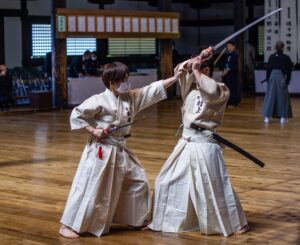 Often, modern budoka tend to find the first part of the event tiring but it needs to be there to remind everyone that their arts didn’t just materialize out of thin air. Kenjutsu, jo, naginata, yari, kusarigama and jutte schools fill the Butokuden’s floor for a the first three hours and groups from all over Japan demonstrate the arts that were the predecessors and the inspiration for today’s kendo, jodo and naginata. The schools that demonstrate include in the kenjutsu section Ono-ha Itto-ryu, Yagyu Shinkage-ryu, Itto-ryu Mizoguchi-ha, Hokushin Itto-ryu, Kogen Itto-ryu, Nitten Ichi-ryu, Tendo-ryu with its the two sword techniques, Shinto-ryu/Shinto Kasumi-ryu, Kurama-ryu, in the naginata-jutsu section, Jikishinkage-ryu and Tendo-ryu, Shinto Muso-ryu and Suio-ryu for the jo section as well as Ikkaku-ryu jutte-jutsu and Isshin-ryu kusarigama-jutsu; all that after an opening from Owarikan-ryu and Hozoin-ryu.
Often, modern budoka tend to find the first part of the event tiring but it needs to be there to remind everyone that their arts didn’t just materialize out of thin air. Kenjutsu, jo, naginata, yari, kusarigama and jutte schools fill the Butokuden’s floor for a the first three hours and groups from all over Japan demonstrate the arts that were the predecessors and the inspiration for today’s kendo, jodo and naginata. The schools that demonstrate include in the kenjutsu section Ono-ha Itto-ryu, Yagyu Shinkage-ryu, Itto-ryu Mizoguchi-ha, Hokushin Itto-ryu, Kogen Itto-ryu, Nitten Ichi-ryu, Tendo-ryu with its the two sword techniques, Shinto-ryu/Shinto Kasumi-ryu, Kurama-ryu, in the naginata-jutsu section, Jikishinkage-ryu and Tendo-ryu, Shinto Muso-ryu and Suio-ryu for the jo section as well as Ikkaku-ryu jutte-jutsu and Isshin-ryu kusarigama-jutsu; all that after an opening from Owarikan-ryu and Hozoin-ryu.
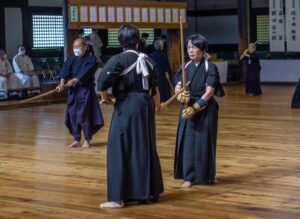
Tendo-ryu two sword techniques
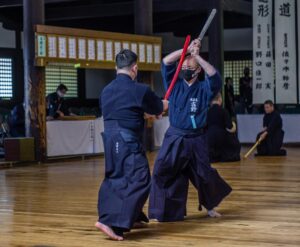
Yagyu Shinkage-ryu


Ono-ha Itto-ryu

Isshin-ryu kusarigama-jutsu

Ikkaku-ryu jutte-jutsu
For the enbu, the room is split in two areas, East and West and there are three pairs demonstrating in each; this means that at any given moment there are a dozen people demonstrating, something very different from the koryu enbu we usually see. And while the participating schools are certainly fewer than in the dedicated koryu enbu, at the Kyoto Taikai you have the chance to see more representatives from each school, coming from different areas and having slightly different approaches to their respective arts. This is particularly true for Shinto Muso-ryu since there were 77 different pairs demonstrating just that art.
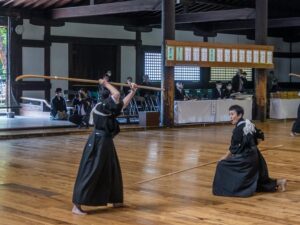
Naginata demonstration
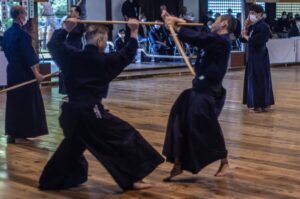
Shinto Muso-ryu Jo

Shinto Muso-ryu Jo

Iaido demonstration
Then, after a presentation of the 12 ZNKR iaido kata by hanshi Sasaki Mikihiko, the iaido section of the event started; there was a similar presentation of the 12 ZNKR Jodo kata by hanshi Fukuda Hirofumi and kyoshi Oniki Masamichi before the jo section. Things here become considerably bigger with 658 practitioners, most of them instructors, demonstrating the classic traditions they study together with the ZNKR material. As expected, the lion’s share here were Muso Shinden-ryu and Muso Jikiden Eishin-ryu but we also got to see Shinkage-ryu, Shindo Munen-ryu, Mugai-ryu, Tenshinsho-den Katori Shinto-ryu, Hoki-ryu, Sekiguchi-ryu, Suio-ryu, Tamiya-ryu, Tatsumi-ryu and Keishi-ryu. Being a student of the late Oda Katsuo hanshi in both ZNKR iaido and Muso Jikiden Eishin-ryu, Mr. Drossoulakis performed a set consisting of the kata Yaegaki, Tsukikage and Oroshi from Muso Jikiden Eishin-ryu and Morote-tsuki and Shiho-giri from the ZNKR iaido, having number 107 at the East side of the hall. For the record, and while he was the only participant from Greece, there were several other participants from other countries as well including the USA, Canada, Belgium, Italy, Sweden and the Netherlands.
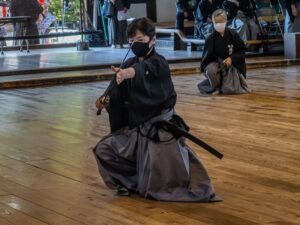
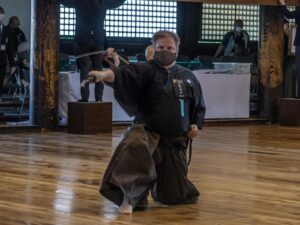
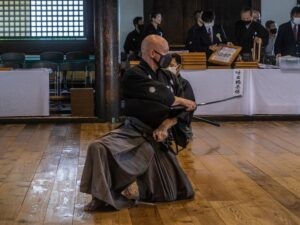
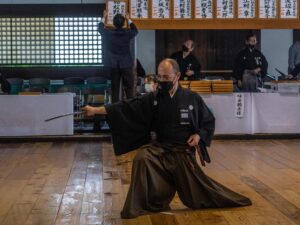
Spiros Drossoulakis
Beware of Greeks bearing swords

Nihon Kendo Kata demonstration by kendo hanshi Noguchi Shinichiro and Makita Minoru
While the first day is the one that will probably appeal the most to practitioners or fans of classical schools, the big event starts the next day, May 3; it is of course the kendo demonstrations where, after a demonstration of the Nihon Kendo Kata by kendo hanshi Noguchi Shinichiro and Makita Minoru, over 2000 kendoka (2074, to be accurate) take turns in 2-point, 3-minute bouts with two pairs fighting at any given moment, one in the East and one in the West. If no points are scored, the bout ends in hikiwake (draw) and such was the bout between Mr. Drossoulakis who was on the fourth bout of the East side, facing Imamura Masao from Yokohama: the two 6th dan renshi tried to find an opening in each other’s defense but apparently there wasn’t any and the bout was terminated before the three-minute mark. Again, Mr. Drosoulakis wasn’t the only non-Japanese participating in the demonstration: also participating were kendoka from Germany, the UK, Australia, New Zealand, the US, the Czech Republic, Singapore, Hong Kong, France, Spain, Italy, Belgium and Canada.
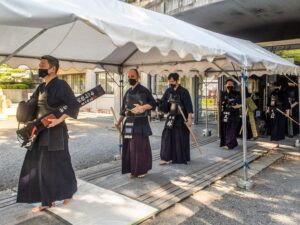

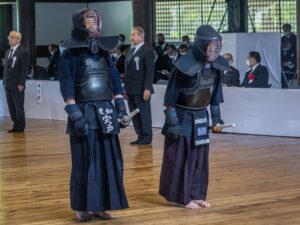
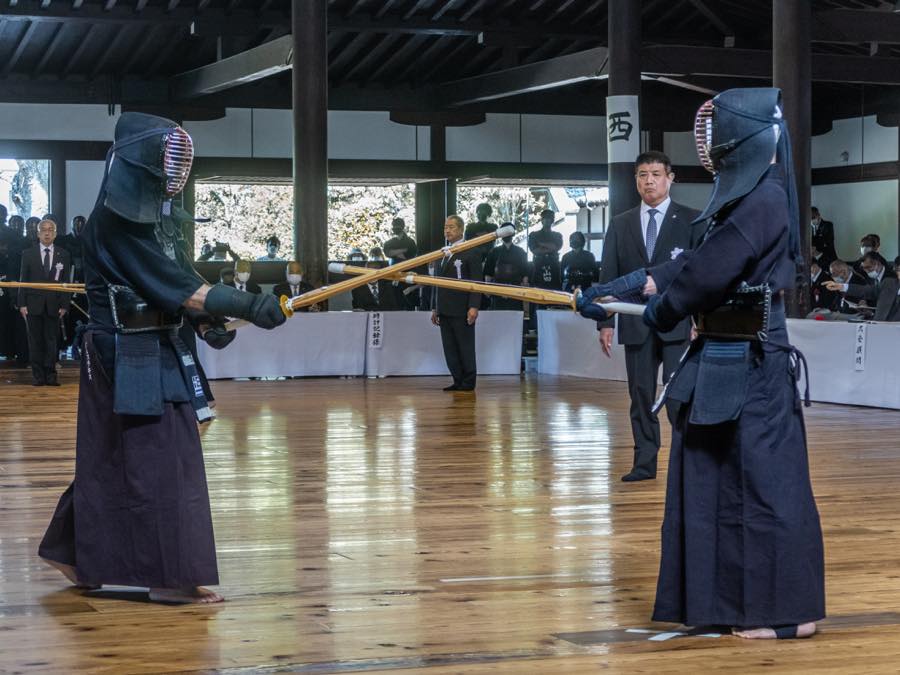
Spiros Drossoulakis facing Imamura Masao from Yokohama
I couldn’t of course not ask Mr. Drossoulakis to say a few words about his experience, his third in the iaido section and the first in the kendo section; here’s what he had to say: participating in the Kyoto Taikai is an amazing experience that any swordsman who is eligible should try. Demonstrating in a space with the history of the Butokuden, surrounded by so many swordsmen is something unequaled and being the only Greek who has participated so far, I am looking forward to other kenshi from my country to follow. Because taking part in the Kyoto Taikai is directly connected to the level and rank of each practitioner, I would like to take the opportunity and say that I owe my being here to my teacher, Oda Katsuo sensei (1942-2020) who gave me the foundations and guided my steps to reach the level I have today. Domo arigato gozaimashita sensei.
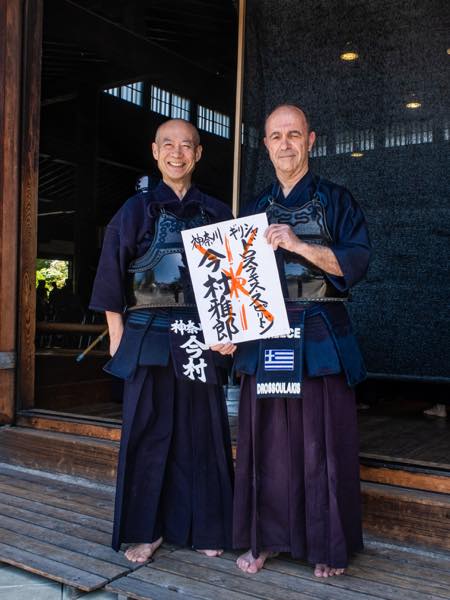
Any report about the Kyoto Taikai cannot end without mentioning the impromptu market outside the Butokuden: for the duration of the event, a dozen or so kendo and iaido equipment dealers and makers, set up tents on the building’s grounds, on its southern side and give participants and visitors the opportunity to catch up with their shopping; while the shops are supposedly there for a last-minute emergency like a broken shinai string or a forgotten iaito cord, most people just indulge their inner consumer. Which, incidentally I don’t blame at all: I too added this year’s official Kyoto Taikai tenugui to my collection and had a nice chat about onigote, the thick padded gauntlets that are the trademark of Ono-ha Itto-ryu.
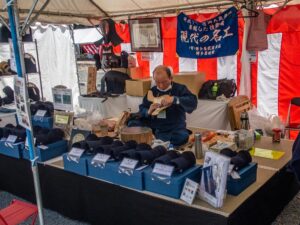
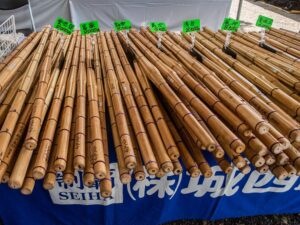
Shimogamo Jinja –and a verdict

Shimogamo Jinja Maidono hall
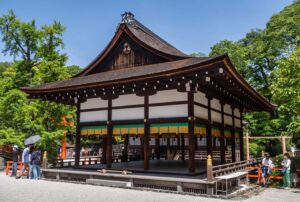
Shimogamo Jinja Hashidono hall
And then was the Shimogamo Jinja demonstration on May 4. After Mr. Drossoulakis’ participation in the Kyoto Taikai, for me this was the highlight of my trip to the old capital since (a), it was the first time I had been to either the event or the shrine itself and (b), my newfound respect for kendo notwithstanding, the world of the classical martial arts is the one I am feeling more comfortable in. As I mentioned earlier, and unlike in Tokyo demonstrations, in Shimogamo the two demonstration areas are in two different structures of the shrine, the Maidono and the Hashidono so watching both is a little challenging: while the distance between the two structures is just a few yards, their position and the orientation of the demonstrators doesn’t really allow having them both in the same field of vision, they are gazebo-styled so their posts often block your view when you are taking pictures; this is even worse in the case of Maidono because it’s elevated.

Ogasawara-ryu horseback archery with mokuba
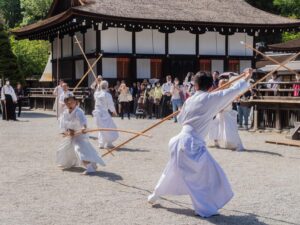
Hozoin-ryu in front of the Maidono
All these aside, it was a good demonstration: exactly because of the layout and the rather small area, the atmosphere was more casual and people could get together in groups and chat, making the whole thing feel more like the community happening that I assume the Shinkokai’s founders wanted their events to be. For me, the opportunity to see for the first time the Ogasawara-ryu demonstrate its horseback archery using a mokuba wooden horse and the Choseikan, the Osaka dojo of Ono-ha Itto-ryu in two of our most advanced sets, Hoshato and Goten and Hozoin-ryu that didn’t use any of the two structures but took up the whole area in front of the Maidono to accommodate its long spears were three of the highlights. But I also enjoyed Jigen-ryu, Sekihguchi-ryu battojutsu and Takenouchi-ryu.

Hosokawake Dento Heiho Niten Ichi-ryu
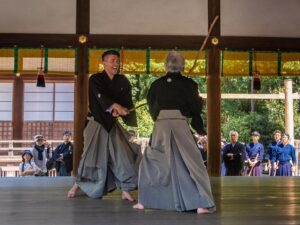
Jigen-ryu
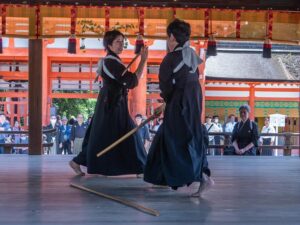
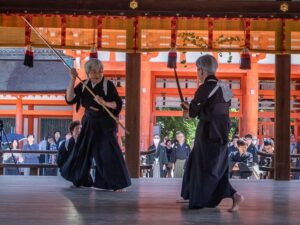
Jikishinkage-ryu
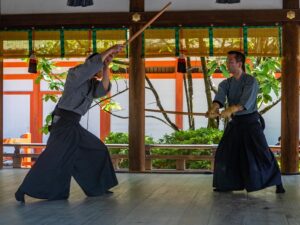
Yagyu shinkage-ryu

Sekihguchi-ryu battojutsu

Yagyu shinkage-ryu

Takenouchi-ryu
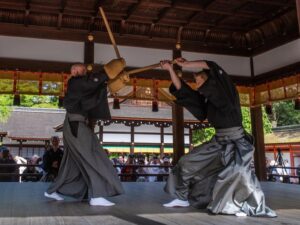
Ono-ha Itto-ryu
Did the whole thing change my attitude towards Kyoto? Not really –besides, this time I was staying in Osaka and commuting every day to Kyoto for the events. (Loved Osaka, BTW, but this is another story!) That doesn’t change the fact though that this first week of May is probably the busiest budo week you can get anywhere in Japan on a regular basis so I think it is necessary for anyone interested in its martial traditions to do it at least once. Despite the challenges they pose for photographers, both the Butokuden and Shimogamo Jinja are certainly worth visiting and during these events they are bustling with energy, reminding everyone that budo is still alive and well in Japan. My only regret was that I had to leave before the final demonstration on May 5 at the Shiramine Jingu shrine. Perhaps next year…
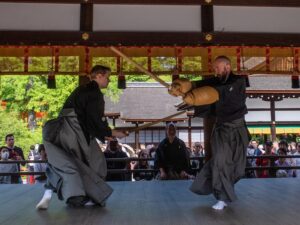
Practitioners from Choseikan, the Osaka dojo of Ono-ha Itto-ryu demonstrating Hoshato

Grigoris Miliaresis
About the writer
Grigoris Miliaresis has been practicing Japanese martial arts since 1986. He has dan grades in judo, aikido and iaido and has translated in Greek over 30 martial arts’ books including Jigoro Kano’s “Kodokan Judo”, Yagyu Munenori’s “The Life-Giving Sword”, Miyamoto Musashi’s “Book of Five Rings”, Takuan Shoho’s “The Unfettered Mind” and Donn Draeger’s “Martial Arts and Ways of Japan” trilogy. Since 2007 his practice has been exclusively in classic schools: Tenshin Buko-ryu Heiho under Ellis Amdur in Greece and Kent Sorensen in Japan and, since 2016, Ono-ha Itto-ryu under 17th headmaster Sasamori Takemi and 18th headmaster Yabuki Yuji.

